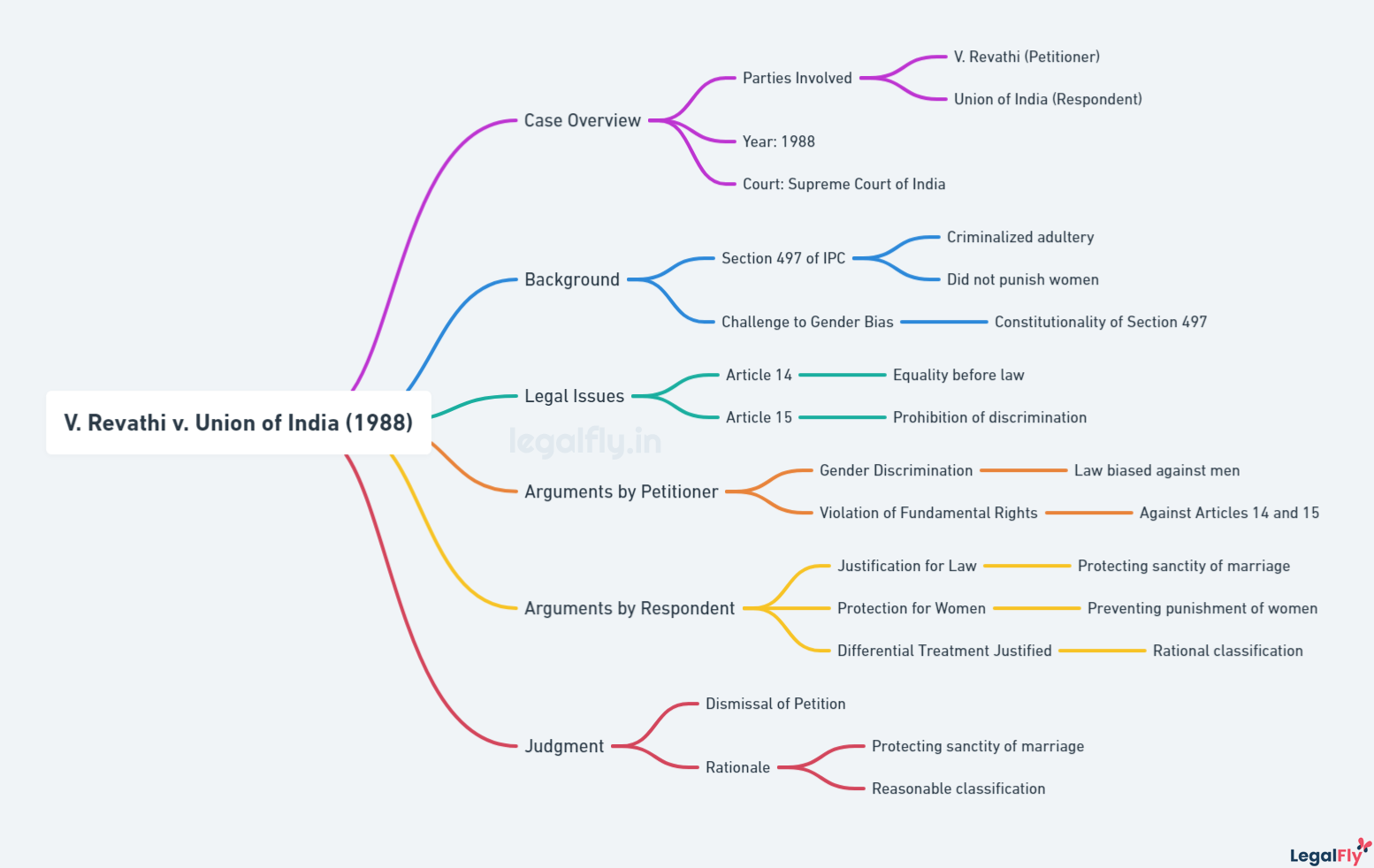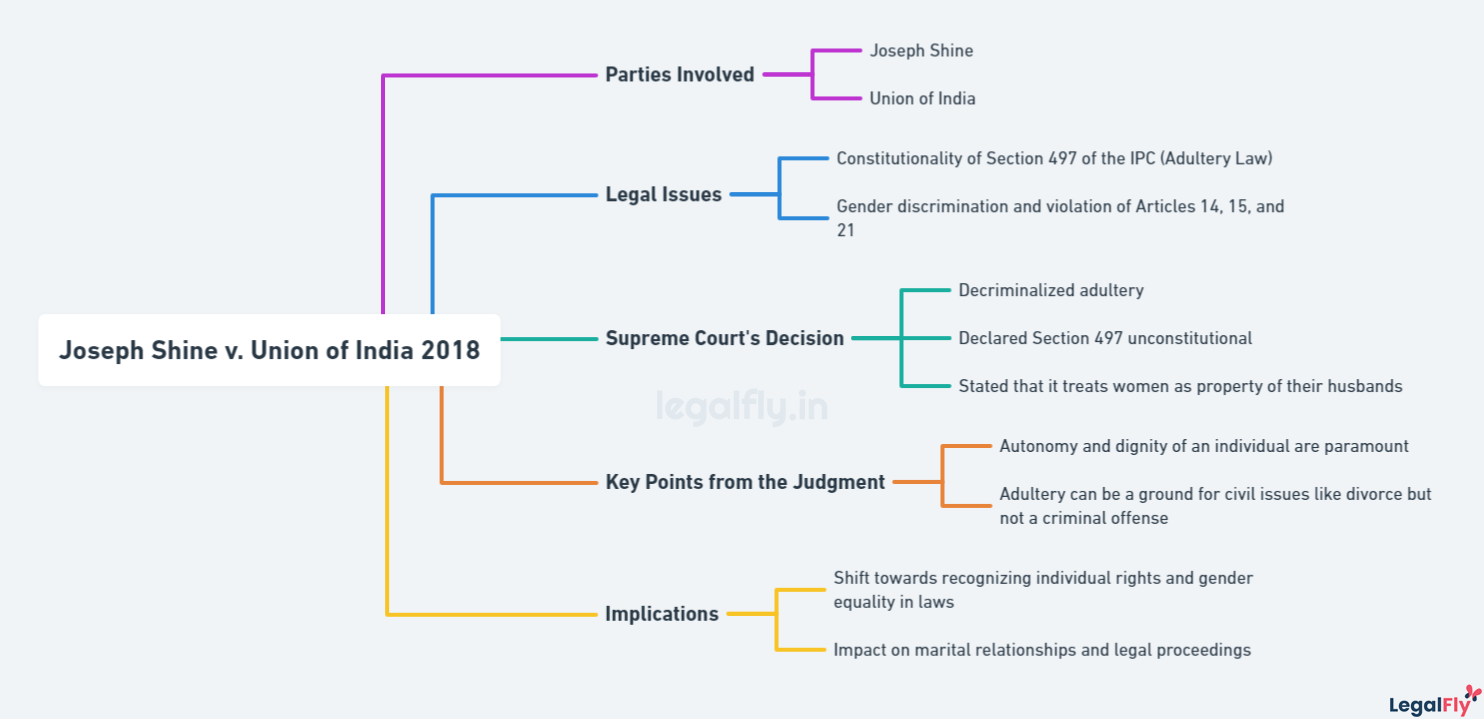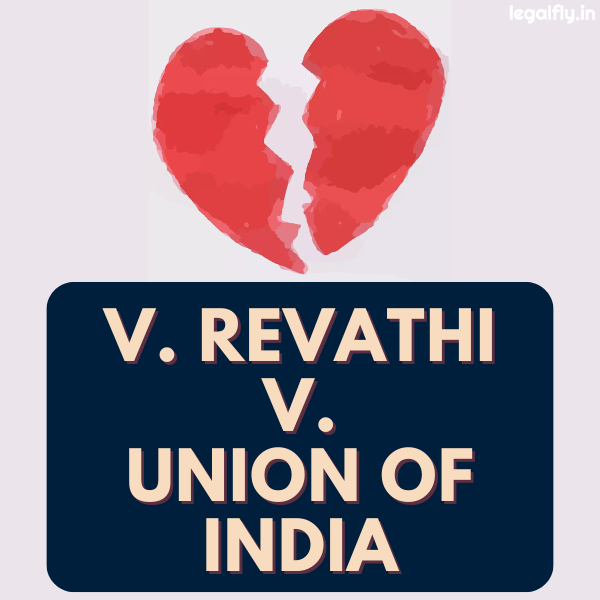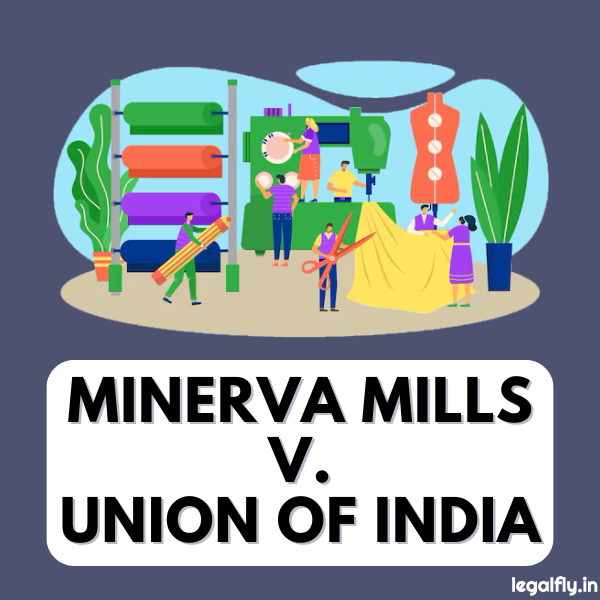Table of Contents
Case Name: V. Revathi v. Union of India
Court: Supreme Court of India
Year: 1988
Citation: AIR 1988 SC 835
Introduction to V. Revathi v. Union of India
V. Revathi v. Union of India (1988) was a landmark case decided by the Supreme Court of India in 1988 concerning the constitutional validity of Section 497 of the Indian Penal Code, which criminalized adultery.
The petitioner, V. Revathi, filed a writ petition under Article 32 of the Constitution challenging Section 497 IPC and Section 198 of the Criminal Procedure Code as being discriminatory against women and violating fundamental rights guaranteed under Articles 14, 15 and 21.

This significant case involved the interpretation of adultery laws in India and their impact on gender equality and the status of women. The Supreme Court ultimately upheld the constitutional validity of Section 497 while reading it down to remove discriminatory aspects.
The V. Revathi judgment represented an important milestone in the evolution of adultery laws in India and their conflict with principles of non-discrimination and gender justice. The case highlighted the complex legal and social issues surrounding the regulation of marital relationships in Indian society.
Background and Context
Adultery laws have existed in India since the mid-19th century under the British colonial administration. Section 497 of the Indian Penal Code (IPC) was enacted in 1860 and criminalized adultery, making it an offence for a man to have sexual intercourse with the wife of another man without his consent.
The law was based on the notion that women were the property of their husbands, reflecting Victorian morals and patriarchal views of the time. Under Section 497, only the adulterous man could be prosecuted, while the woman involved was exempted from punishment. However, the law did not allow women to file a complaint against their husbands for adultery.
This reflected the subordinate status of women in Indian society, where they lacked rights and agency over their sexuality. By the 1980s, Indian society was undergoing rapid social change. Women’s rights movements questioned patriarchal attitudes and campaigned for gender equality and sexual autonomy.
Importance of the Case
The V. Revathi v. Union of India 1988 case was the first direct challenge to the constitutionality of Section 497 of the Indian Penal Code, which criminalized adultery. It marked a significant development in the legal discourse on gender equality and women’s rights in India.
The case is notable because Revathi, the petitioner, contended that Section 497 was discriminatory as it did not give the wife of an adulterous man the right to prosecute him. She argued that the law, by excluding the wife from filing a complaint, treated her as her husband’s subordinate.
Although the Supreme Court ultimately upheld the validity of Section 497 in this case, the judgment highlighted how the adultery law could be seen as perpetuating gender inequality. By denying aggrieved wives legal recourse against unfaithful husbands, the law was criticized for promoting patriarchal notions of marriage.
The V. Revathi case paved the way for future legal challenges to Section 497 on the grounds of discrimination and violation of constitutional rights. It marked the beginning of a broader struggle for gender justice and a more egalitarian adultery law in India. Though unsuccessful, Revathi’s petition was an important milestone in the legal empowerment of women.
Key Facts of the Case
The V. Revathi v. Union of India case was filed in the Supreme Court in 1988 by petitioner V. Revathi, challenging the constitutional validity of Section 497 of the Indian Penal Code (IPC), which criminalized adultery. Revathi argued that Section 497 was discriminatory on the basis of sex as it did not give women the right to prosecute their husbands for adultery. She also challenged Section 198 of the Criminal Procedure Code (CrPC), which required that only the husband of the adulterous woman could file a complaint, not the wife of the adulterous man.
The key legal provisions challenged were:
- Section 497 IPC which defined adultery as a criminal offence only between a man and a “married woman”.
- Section 198(2) CrPC which specified that only the husband could be the complainant in adultery cases.
Revathi argued these provisions were discriminatory against women and violated constitutional rights to equality under Article 14 and the right to life and personal liberty under Article 21.
Legal Issues Addressed
The main legal issues addressed in V. Revathi v. Union of India were claims of gender discrimination under Section 497 IPC and constitutional challenges to the validity of the adultery law.
Gender Discrimination Claims
The petitioner, V. Revathi, argued that Section 497 IPC was discriminatory against women as it did not give wives an equal right to prosecute adulterous husbands. She contended that the law created an arbitrary distinction based on gender and went against the spirit of equality enshrined in the Constitution. The Supreme Court, however, upheld the constitutionality of Section 497 and stated that it was enacted to protect the sanctity of marriage.
Constitutional Challenges under Articles 14 and 32
In addition to gender discrimination claims, the petitioner also raised constitutional challenges to Section 497 IPC under Articles 14 and 32 of the Indian Constitution. Article 14 guarantees equality before the law, while Article 32 gives citizens the right to approach the Supreme Court for enforcement of fundamental rights. However, the Supreme Court rejected these arguments and held that Section 497 was a valid classification and did not violate constitutional provisions.
Arguments Presented
The petitioner, V. Revathi, argued that Section 497 IPC violated Articles 14, 15 and 21 of the Constitution as it discriminated based on sex. She contended that the law treated women as the property of their husbands and imposed gender-based inequality.
The key arguments presented by the petitioner were:
- Section 497 IPC was unconstitutional as it classified adultery as an offence committed by men but not women. This violated Article 14 on equality before the law.
- The law deprived women of the right to prosecute their husbands for adultery, violating their right to equality under Article 14.
- Section 497 infringed upon the personal liberty of women guaranteed under Article 21 by treating them as their husband’s property.
- The law perpetuated gender stereotypes and was based on paternalistic notions of women’s role in marriage.
The Union of India defended the constitutionality and validity of Section 497 IPC. Their main arguments were:
- Adultery law preserved the sanctity of marriage, which was crucial for social good and public morals.
- It protected marital harmony by criminalizing sexual relations outside marriage.
- The law treated women differently to protect them from prosecution, not to discriminate.
- Any inequality in adultery law was reasonable classification, not violating Article 14.
Supreme Court’s Decision and Rationale
The Supreme Court upheld the constitutional validity of Section 497 IPC and Section 198 CrPC in its judgment. The Court interpreted Section 497 IPC to be a special provision made by the legislature in dealing with the offence of adultery to protect and preserve the sanctity of marriage. It serves as a shield rather than a sword.
The Court examined the scope and ambit of Section 497 IPC and 198 CrPC and held that they do not violate Articles 14, 15 or 21. It ruled that Section 497 IPC is a special provision made for women as a class to protect and preserve the sanctity of marriage. Therefore, it does not discriminate based on sex.
The Supreme Court also analyzed the legislative intent behind Section 198 CrPC. It serves to provide a safeguard against the unwanted prosecution of women when they may be forced into adultery due to circumstances. The Court upheld Section 198 CrPC as a valid classification made by the legislature.
Overall, the Supreme Court’s rationale focused on interpreting the laws to uphold the social good of preserving marriages. The Court felt the laws did not violate constitutional provisions when seen in light of their aim to maintain matrimonial harmony.
Implications of the Judgment
The judgment in V. Revathi v. Union of India had significant implications for adultery laws and gender equality in India. Despite upholding Section 497 IPC, the case brought national attention to discriminatory aspects of adultery laws.
Impact on Adultery Laws in India
Although the Supreme Court upheld Section 497 IPC in the V. Revathi case, the judgment fueled further legal challenges to adultery laws on the grounds of gender discrimination. This culminated in the 2018 judgment in Joseph Shine v. Union of India, which struck down Section 497 as unconstitutional. However, the V. Revathi v. Union of India case was an important milestone that highlighted issues in adultery laws.

Influence on Gender Equality and Family Law
The V. Revathi v. Union of India judgment reflected the ongoing evolution in society’s views on gender roles and equality within marriage. Although the Court upheld Section 497 IPC in this case, the petitioner’s arguments helped advance public discourse on gender bias in adultery legislation, bringing national attention to these issues.
Broader Legal and Social Consequences
Despite upholding Section 497 IPC, the V. Revathi v. Union of India case fueled debate on privacy, liberty and gender equality within Indian families. This shifted social views on adultery and sparked legal reform efforts. The judgment also demonstrated the judiciary’s role in balancing tradition and modernity when interpreting personal laws.
Conclusion
The Supreme Court’s judgment in V. Revathi v. Union of India (1988) was a landmark case regarding adultery laws in India that upheld the constitutionality of Section 497 IPC. The key takeaways from the case were:
- The Court interpreted Section 497 IPC to only criminalize adultery by a man with a married woman, excluding adultery by a married man or unmarried persons. This was deemed constitutionally valid.
- Section 198 CrPC barring women from filing complaints under Section 497 IPC was upheld as procedurally valid.
- Gender discrimination claims were rejected, with the Court viewing Section 497 IPC as intended to preserve the sanctity of marriage.
- The Court ruled that Section 497 IPC served a social purpose in preventing the breakdown of marriages, upholding it under Article 14.
- Arguments that the law violated personal liberty under Article 21 were rejected, viewing the law as a reasonable restriction.
The V. Revathi judgment had significant implications for adultery laws and gender equality in India. Though it upheld Section 497 IPC, it reflected social mores regarding adultery at the time. With evolving social attitudes, the case remains relevant in evaluating India’s contemporary legal approach to adultery. The judgment provides insights into balancing constitutional rights, discrimination issues, and societal interests regarding marriage and family. Though parts were overturned later, V. Revathi is a milestone in India’s adultery law jurisprudence.
Frequently Asked Questions
What was Section 497 IPC?
Section 497 of the Indian Penal Code made adultery a criminal offence. It stated that “Whoever has sexual intercourse with a person who is and whom he knows or has reason to believe to be the wife of another man, without the consent or connivance of that man, such sexual intercourse not amounting to the offense of rape, is guilty of the offense of adultery.” The provision treated women as the property of their husbands and did not give women an equal right to prosecute adultery.
How did the V. Revathi judgment affect women’s rights?
By upholding the constitutionality of Section 497 IPC, the V. Revathi judgment was seen as a setback for women’s rights and gender equality. Even though the Court acknowledged that the law was discriminatory against women, it ruled that discrimination could be allowed if it served a social purpose, like preserving the sanctity of marriage. This reinforced patriarchal notions about marriage and denied women equal status under adultery laws.
What is the current status of adultery laws in India?
In 2018, a Five-Judge Bench of the Supreme Court struck down Section 497 IPC and Section 198 of the CrPC in the Joseph Shine case as violative of Articles 14, 15, and 21 of the Indian Constitution. The Court ruled that adultery can no longer be considered a criminal offence in India. Adultery is now grounds for divorce under civil law. However, the striking down of Section 497 removed the provision that punished only men for adultery, thereby making the law gender-neutral.




